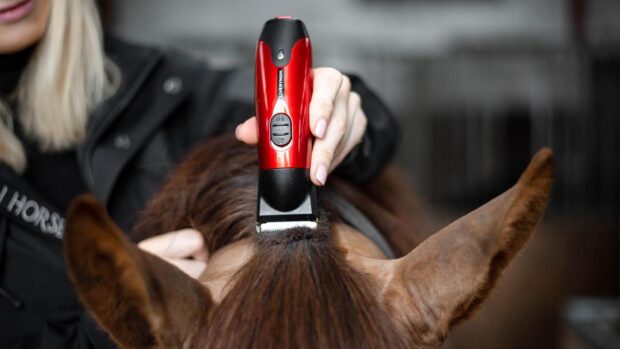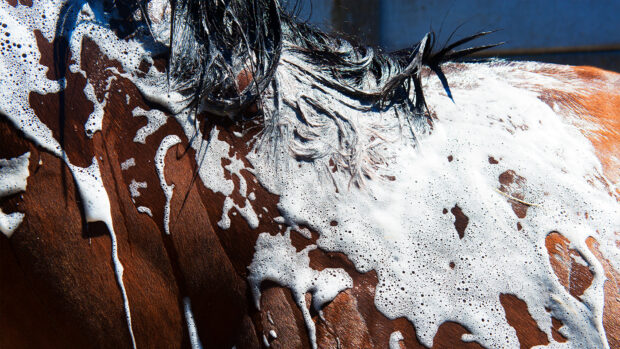Horse & Hound spoke to Tracey Freeman, who makes a living cleaning sheaths across the country
How did you get into sheath cleaning?
I had always cleaned my own horses’ sheaths and I just thought everyone did it routinely.
I am based at Gleniffer Stables near Maidenhead in Berkshire, which used to be run by the late Russell Pearson. I was the yard manager for many years and used to clean the 60 horses stabled on the yard.
It all started when a friend asked if I could clean her horse and I told her she could try doing it herself and her reply was “no, I couldn’t do that!”
So I went along and cleaned her horse. She then recommended me to another friend, and people started asking me to come and clean their horses. I discovered a niche in the market that could also make me money.
I set up Sheath Cleaning UK, charging £25 per session, and started a Facebook page, which received a great response and brilliant reviews, and it just went from there. It is now my full-time job and I am doing it six or seven days a week.

What is a ‘bean’?
The ‘bean’ is the common name for a collection of smegma in the tip of the horse’s penis. The tube that the urine passes through is called the urethra and just above the urethra is a pocket of space called the urethral fossa and this is where the build up of dirt and grime happens, which results in hardened ‘beans’. When the beans get so big, they interfere with the horse’s ability to pass urine properly, which can lead to all sorts of infections and kidney problems. Generally, when horses have severe beans, they will be in obvious discomfort.
Why is it important to clean your horse’s sheath?
Every male horse will get beans and a build up of smegma, due to the inevitable build up of grime. Having beans will cause your horse discomfort, a bit like walking with a stone constantly in your shoe.
The signs that your horse needs his sheath cleaned include having problems passing urine and you will visibly see build up of smegma on the outside of the penis. Most horse owners will also be able to feel the beans, although it is harder to remove them.
I have also found a number of melanomas on horses through doing my job, some of which have been able to be treated and sadly some bigger tumours that couldn’t — that is why it is important for owners to be aware of what is going on under there.
Ideally, for horses over the age of four, you should clean the sheath once a year.
What’s the biggest size bean you have seen?
The biggest bean I have removed was bigger than a fifty pence piece (pictured, below) — it was more like the size of a golf ball.
The feedback I get from owners is that their horses are so different in their temperament after having beans removed. They are more comfortable and happier within themselves.

Do you only treat geldings?
I mostly treat geldings, but I have also cleaned a few stallions, and a donkey. Although the stallions end up enjoying it far too much!
I have clients across the disciplines, including ponies, ex-racehorses and showjumpers. I visit Robert Whitaker’s yard to clean his horses and have treated his top horse, Catwalk IV.
How do you deal with tricky horses?
I would say that 99% of horses will start off being difficult but I can guarantee, if a horse has beans, they will stop being tricky pretty soon — it is almost like they are asking you to remove the bean. They are often relieved straight away and visibly more comfortable. Sometimes horses need to be sedated by a vet first but that is rare.
What is the process involved in removing a bean?
There is strictly no scrubbing! You will often hear of owners scrubbing the sheath area with soapy water but this is the worst thing you can do.
It is such a delicate area and you have to be gentle. I use no chemicals or baby oil, because that just attracts grit. I simply use KY Jelly, a water-based lubricant, and vinyl gloves — never latex gloves.
I will often lubricate the sheath first and leave it for a bit while I treat another horse, and then by the time I have come back to it, the beans will have loosened up and they are easier to remove. Owners should not be picking the smegma off either.
I just spend a few minutes massaging the beans out — I always manage to get them out.
How did you get the name ‘The Bean Queen’?
It was after I had been to one yard and treated 16 horses and removed 16 beans. My husband told me I was ‘The Bean Queen’ and then one owner sent me a set of overalls with it written on the back and it just stuck.
What do you enjoy most about your job?
I have been cleaning sheaths for 29 years now and it is a job that takes me all over the country — I was in the Isle of Wight recently. Yes, I am up to my arms in muck each day, every day but I love my job. It is so important and I like that I am doing something for the welfare of the horse, I treat each horse like my own. It is fun too and I get to meet lots of new people. In a week, I can be treating up to 100 horses.




